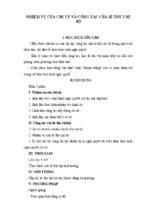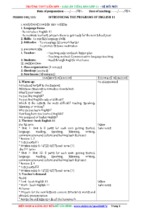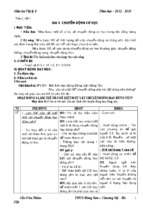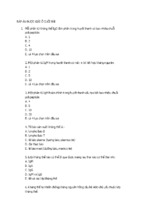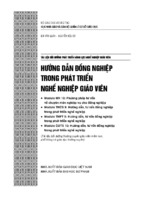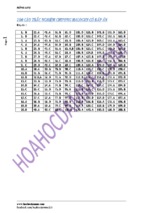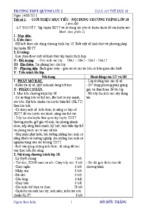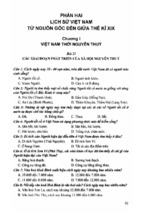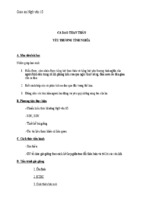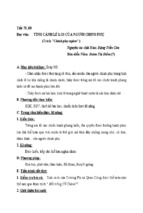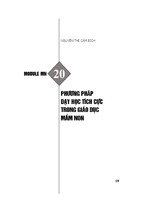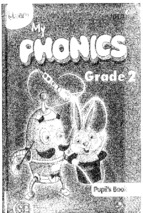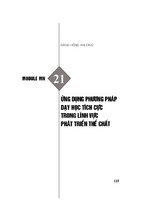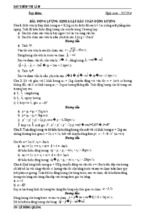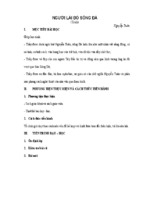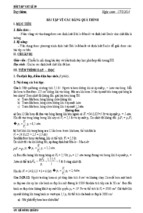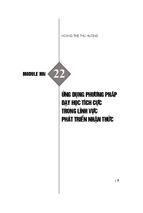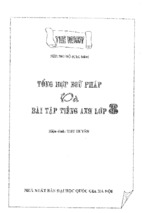Bộ GIÁO DỤC VÀ ĐÀO TẠO
HOÀNG VĂN VÂN (Tổng chủ biên) - LƯƠNG QUỲNH TRANG (Chủ biên)
NGUYỄN THị CH! - LÊ KIM DUNG - PHAN CHÍ NGHĨA - NGUYỄN THỤY PHƯƠNG LAN - vũ MAI TRANG
Với Sự cộng tác của DAVÍD KAYE
. Sầch thíđiểrri
- Reading for general and
specific information about
a traditional craft village
- Discussing local
traditional crafts, their
benefits and challenges
- Reading for specific
- Talking about
information about the factors of a city
features of cities
íiủv:':;.
Life m tihe
y iHiLt ■$)?,
&
iJy'jd!
- Reading for general
and specific Information
about a helpline service
for teens
important
-Talking
about
teen
stress and pressure and
howto cope with them
- Listening for specific
information about
places of interest in
an area
- Listening for specific
information about
some problems of
city life
- Listening for general
and specific information
about the work of an
advice columnist
- Reading for specific
information about
children's pastimes in
the past
- Making comments on
or expressing opinions
about facts in the past
- Listening for specific
information about
school life in the past
Reading for specific
information about a
man-made wonder of
Viet Nam
■Talking about wonders of
Viet Nam and how to
protect and preserve them
- Listening for specific
information about a
natural wonder of Viet
Nam
Reading for general and
specific information about
the tram system in Ha Noi
then and now
-Talking about changes
in transport in the
neighbourhood and
expressing opinions
about these changes
- Listening for general
and specific
information about life
in an extended family
-Writing an email to give
information about
places of interest in an
area and things to do
there
Complex sentences (adverb
clauses of result, reasons,
concession): review
Phrasal verbs
Pronunciation: Stress on
content words in sentences
Arranging a visit to a
place of interest in the
region
Giving a
presentation
about
something
special in an
area
- Writing a paragraph
about disadvantages/
drawbacks of city life
Comparison of adjectives
and adverbs: review
Discussing some
features of a city
Writing notices
- Writing a short note to
ask for advice and to
give advice
Reported speech: review
Question words before foinfinitive
Pronunciation: Stress on the
verb be in sentences
- Writing a description
of how children in the
past studied without
technology
Phrasal verbs (continue)
Pronunciation: Stress on
pronouns in sentences
■
■
Used to: review
Wishes
for
the
present
• Pronunciation: Stress on
auxiliary verbs in sentences
Discussing necessary
life skills for teens
Giving a
presentation
about a support
group in the
school
Describing past
practices
Making a poster
on the
preservation of
a past tradition
or pastime
-Writing an article
describing a wonder of
Viet Nam
Passive voice: impersonal
passsive
suggest+verb-ing/suggest
(that) + subject 4- should
Pronunciation: Stress on
short words (a, of, or) in
sentences
Describing a wonder
of Viet Nam
Making a
promotional
brochure about
a wonder of Viet
Nam
- Writing about some
qualities a person
needs to get along in
an extended family
Past perfect: review
Adjective + fo-infinitive;
Adjective + that-dause
Talking about some
changes in Viet Nam
Making a photo
exhibition about
school life in
Viet Nam then
and now
Pronunciation: Stress on ail
the words in sentences
LOCJU. INVIIỠNM1NĨ
... T3 ss*r 6 8|5ST 3ỊM>ri
I His yim t ireWS-lWEL-i*
GCfflEDSTEQIID
A visit to a traditional
craft village
TraditíOnsỉ cxsíts Places of ỉíìíeresĩ'
PEOI^y^ẵOẤl ÌONI
Stress on corÈteỉit V'iGi'ds ỉn ssnísricss
6KAIVĨIVỈAR
Compỉex sentences: review
Phrasaì verbs
SKILLS
= ReadiiìQ for gerseras srỉđ specific Information about a
tradrdonaỉ craft Visiage
c
Dỉscussỉrỉ9 ?ocas írađỉíỉQỉiaỉ
» Listemna for
specific information a&out pỉaces of interest in sn area
crafts, thesr berietĩts znỏ chaỉỉenges
o WrstiHG an err«sH to Give information! abũiĩ.í p!acesof
interest in afỉ area and things to ■do there
IBMMUNIOKIOII
Arrancincf 2 visit to a piace of interest in the
region
Listen and read.
Nick:
Thereareso many pieces of pottery here,
Phong. Do your grandparents make all of
them?
Phong: They can't because we have lots of products.
They make some and other people make the
rest.
Nick:
As far as I know, BatTrang is one of the most
famous traditional craft villages of Ha Noi,
right?
Phong: Right. My grandmother says it's about 700
years old.
Mi:
WowiWhen did your grandparents set up
this workshop?
Locbi ivif Uìì: ì :8i u.
Phong: My great-grandparents started it, not my
grandparents. Then my grandparents took
over the business. Aff the artisans here are my
aunts, uncles, and cousins.
Mi:
I see. Your village is a iso a place of interest of
Ha Noi, isn't it?
Phong: Yes. People come here to buy things for their
house. Another attraction is they can make
pottery themselves in workshops.
Nick:
That must be a memorable experience.
Phong: In Viet Nam there are lots of craft villages like
BatTrang. Have you ever been to any others?
Mi:
I've been to a conical hat making village in
Hue!
Nick:
Cool! This is my first one. Do you think
that the various crafts remind people of a
specific region?
Mi:
Sure, it's the reason tourists often choose
handicrafts as souvenirs.
Phong: Let's go outside and look round the village.
Qũ Can you find a word/phrase that means:
a thing which is skilfully made with your hands start
something (a business, an organisation, etc) take
control of something (a business, an organisation,
etc.)
; . people who do skilled work, making things with
their hands
s .an interesting or enjoyable place to go or thing to
do X a particular place
make someone remember or think about something
S. walk around a place to see what is there
Complete the sentences with the words/ phrases
from % to show where in Viet Nam the
handicrafts are made. You do not have to use
them all.
The birthplace of the famous bai tho................ ..... is
Tay Ho village in Hue.
th
If you go to Hoi An on the 15 of each lunar month,
is Answer the following questions.
;, Where are Nick, Mi, and Phong?
2, How old is the village?
3» Who started Phong's family workshop? ■ i Why is
the village a place of interest in Ha Noi?
5, Where is the craft village that Mi visited?
5, Why do tourists like to buy handicrafts as souvenirs?
% Write the name of each traditional handicraft in the
box under the picture.
you can enjoy the lights of many beautiful
.
Van Phuc village in Ha Noi produces different
types of _____ products such as cloth, scarves,
ties, and dresses.
On theTet holiday, many Hanoians go to Dong
Ho village to buy folk........ .....
__products of Bau True, such as pots and
vases, have the natural colours typical of Champa
culture in Ninh Thuan.
Going to Non Nuoc marble village in Da Nang,
we're impressed by a wide variety of ________ __
from Buddha statues to bracelets.
"pal retinas ; poiterv drums SĨỈÍC ■ l a n t e r n s
conical hats .lacqụervvarẹ ; rnarbie sculptures
N
ị|ÌỊjỊ^y j VsỊ
Work in pairs to do the quiz.
1 < People go to this area to walk, play, and relax.
2. It is a place where objects of artistic, cultural,
historical, ơr scientific interest are kept and shown.
3. People go to this place to see animals.
4. It is an area of sand, or small stones, beside the sea
or a lake.
5. It is a beautiful and famous place in the countryside.
1} Work in groups. Write a similar quiz about places
of interest. Ask another group to answer the quiz.
unit 1 / Locsi tnvironment 7
. ........... .£.■
imcabulmf
ĨỈ Write the verbs in the box irnder the pictures. One of
them shouid be used twice.
: carve
embroider
cast
knit
weave
rnoaỉđ
§3 What are some places of interest in your area?
Complete the word web. One word can belong to
more than one category.
Entertaining
Educational
- cinema
- library
Places
of
interest
Cultural
Match the verbs in coSomn A
nouns in coSumn B„
L carve
5. handkerchiefs,
With
the groups of
knit
■&. mould
attraction historical
. handicrafts
. culture
Í. sweaters, toys, hats
has to be so limited, [n my opinion, a place of
interest is simply one that people like going to.
È) Now write the correct verb forms for these
verbs.
jj
1 1- to carve
Ỉ carved it. : It was carved. Ị
: 2, to cast
1 it. ! It was
, 3. to weave
] _ ___ it. 1 It was ________ . :
■ 5. to knit
1 it. ■ it was
: 6, to mould
1 .... ... it. It was .
8 Unit 1/ Local Environment
£
;
tradition?;
exercise
Some people say that a place of interest is a place
famous for
its scenery or a well-known OL... site. 1 don't think it
e. baskets, carpets, silk, doth
■■■■
building
$ Complete the passage by filling each blank with a
suitable word from the box.
tablecloths,
b. stone, wood, eggshells
d. bronze, gold, iron
4, to embroider 1 it. It was
Historical
-
pictures
2. cast
embroider
- opera house
In my town, the park is a(n) (2) . because
many
people
love spending time there. Old people do (3)
________________________________ and walk
in the park. Children play games there while their
parents sit and talk with each other. Another ptace
of interest in my town
is Hoa Binh market. It's a(n) (4).market with a lot of
things to see. I love to go there to buy food and
clothes, and watch other people buying and
Stress on content wards in sentences
a;.: Listen to the speaker read the foi!owisig sentences
and answer the questions.
521
The craft village lies on the river bank.^s
painting is embroidered.
Compỉex sentences: trevsew
There are different types of dependent clause.
55
® ^ This
v
f#}
What is this region famous for?
A dependent clause of concession begins with a
subordinator although, though, or even though.
It shows an unexpetted result.
Drums aren't made in my village.
A famous artisan carved this table beautifully.
Although she was tired, she finished knitting the
scarf for her dad.
Which words are louder and clearer than the
others?
A dependent clause of purpose begins with a
subordinator so that or in order that It tells the
purpose of the action in the independent clause.
What kinds of words are they?
The artisan moulded the day so that he could make
a mask.
Which words are not as loud and clear as the
others?
A dependent clause of reason begins with a
subordinates because, since, or as. It answers the
question “Why?”
What kinds of words are they?
Since it was raining, they cancelled the trip to Trang
An.
lb Now listen, check, and repeat.
A dependent clause of time begins with a
subordinates when, while, before, after, OS soon
as, etc It tells when the action described in the
independent clause takes place.
In spoken ‘English, the following kinds of words are
usually stressed: main verbs, nouns, adjectives,
adverbs,
wh-question
words,
and
negative
auxiliaries (e.g. don't).
When I have free time, Í usually go to the museum.
Words such as pronouns, prepositions, articles,
conjunctions, possessive adjectives, be (even if it is
[■ Underline the dependent cỉaiĩse in each
a main verb in the sentence), and auxiliary verbs
sentence beỄow. Say whether it is a dependent
clause of concession (DC), of purpose (DP), of
reason (DR), or of time (DĨ).
are normally unstressed.
When people talk about traditional paintings, they
think of Dong Ho village.
ổc: Underline the content words in the sentences.
Practise reading the sentences aSoud.
, The Arts Museum is a popular place of interest in
my city.
. This cinema attracts lots of youngsters.
The artisans mould day to make traditional pots.
Where do you like going at weekends?
We shouldn't destroy historical buildings.
; Now listen, check, and repeat.
L My sister went to Tay Ho village in Hue so that she
could buy some bai tho conical hats.
; Although this museum is small, it has many unique
artefacts.
This square is our favourite place to hang out
because we have space to skateboard.
5 The villagers have to dry the buffalo skin under the
sun before they make the drumheads.
‘â Make a complex sentence ĩroĩTỉ each pair cf
sentences. Use the siíbordĩsiatoír sròviided and
make any necessary changes.
The villagers are trying to learn English.They can
communicate with foreign customers, (in order that)
We ate lunch. Then we went to Non Nuoc marble
Q Match the phrasal verbs m A wsth their meaning
in B.
pass down
•
stop doing business
live on
have
village to buy some souvenirs, (after)
This hand-embroidered picture was expensive. We
bought it. (even though)
:
. This department store is an attraction in my city.
somebody
The products are of good quality, (because)
This is cailed a Chuong conical hat. it was made in
Chuong village, (since)
5. face up to ■■■:.
Read this part of the conversation from GETTING
STARTED. Pay attention to the underlined part and
answer the questions.
Mi: Wow!When did your grandparents ;
set UP this workshop?
;■
Phong: My great-grandparents started it, not my I ^ "
grandparents. Then my grandparents ệ took over the
business.
■
, What is the meaning of the underlined verb
phrases?
Can each part of the verb phrase help you
understand its meaning?
A phrasal verb is a verb combined with a particle such
as back, in, on, off, through, up, etc. When a ; particle is
added to the verb, the phrasal verb usually has a special
meaning.
Bíttííĩpic::
j
get up (get out of bed) find
out (publish/launch) look
through (read)
Note: A verb can go with two particles.
biampie:
keep up with (stay equal with)
look forward to (be thinking with pleasure about
something to come)
run out of (have no more of)
friendly
relationship
with
transfer from one generation to the
next
4, closedown
reject or refuse something
return
V get on with:take action to solve a problem
? comeback. have enough money to live
o.. turndown
Phrasal verbs
out {get information) bring
3 . deal with
a
accept, deal with
ễ Complete each sentence using the correct form of
a phrasai verb in 43. You don't need to use ail the
verbs.
1, - ....................We must
the reality
that our handicrafts
are in competition with those of other villages.
2, I invited her to join our trip to Trang An, but she
.... ...... my invitation.
3, The craft of basket weaving is usually ..... .
from
generation to generation.
4, Do you think we can _____ ... selling silk scarves
as
souvenirs?
5, They had to ............the museum because it's no
longer a place of interest.
6, What time ____ ..... you ___ from the trip fast
night?
(ằ Complete the second sentence so that it has a
similar meaning to the first sentence, using the
word given.
1. Where did you get the information about
Disneyland Resort?
find
Where __ _____ __ ______ ___ _______ ?
2. What time did you get out of bed this morning?
up
When _____ ___ ___ __ ____ ____ ___ ___ ?
3. ru read this leaflet to see what activities are
organised at this attraction.
look
111 ___ ___ ___ __ ____ _ _______ ___
_____
Í . They're going to publish a guidebook to different
beauty spots in Viet Nam. out
They're. ....... ................... ................... ......
10 L’nlv 1/ Locs 1 Environm ent
£
Extra vocabulary
team-building
turnup
setoff
Li Nick, MỈ, Duong, and Mai are pfenning a day out to a piace of interest for their class. Listen to their conversation
and complete their plan by filing each blank with no more than three words.
A DAY OUT
Place
(1)
Means of transport
(2) ........... ................... .......... ..........
Time
to se'i off Food
...........................................................................................................................................................................
.................
Mai: stick a notice
(3 ) ......... .......... ..... .... ..............
Drinks
Ac ị lv!
.......... ..........
(4) bring... ................. .... ..............
For everyone
Morning: (6) ........
Nga: buy in (5) .....
games
and
quizzes
games
Lunch: 11.30
(7)...
Afternoon: go to traditionai {8}.............
at 1.30; (9) ____their own paintings
Nick:
Thanh:
prepare
prepare
(10) ......... ................... ...............
......
si Imagine that your dass is going to a place OĨ hiteresi m your area.
Work in groups to discuss the plan for this day out. Make notes in the table.
Means
Ixsnspor!:
of
7Ì/TÌS
Drinks
AcLÌviiiÍGs
Tima to come back
13 Present your pSan to the dass. Which group has the best plan?
jfifc 1 / Lccái briVỈ;“cn:rìsni: 11
$
A conical hat may look simple, but artisans have to
follow Ì 5 stages, from going to the forest to coliedleaves to ironing the leaves, making the frames, etc.
Hue's conical hafs always have two layers of leaves.
Craftsmen must be skilful to make the two layers
very thin, what is special is that ihey then add
poems and paintings of Hue between the two
layers, creating the famous boi tho or poetic conical
hats.
Work in pairs. Orae itaoks at Picture A, arcd the
other looks at Picture B on page 15. Ask each other
questions to find out the simsSaritses arsd
differences between your pictures.
Picture A
Conical haf making in the
viltage has been passed down .
;
from generation to generation
because everybody, young or old,
can take part in the process. If is a
weli-known handicraft, not only in
Vief Nam, but ail around the world.
% MB visited lay Ho village ìn Hue ỉasí mosratfo. She
has decided to present what she knows about ỉhỉs
pỉace to the class.
Read what she has prepared and match the tâtỉes
with the paragraphs.
® Head the text agassi and answer the questions.
1. Why is Tay Ho the most well-known conical hat
making village?
2, How far is it from Tay Ho to Hue City?
3. What is the first stage of conical hat making?
.} Present status of the craft
4, What is special about the hat layers?
5. What is special about the bơi tho conical hat?
: 2~: Location and history of conical hat /
making village
6, Who can make conical hats?
H2Ỉ
S' Yg §*5*5
fW? ÍSỈ fie Ííĩ* !i s E Vc<|
% Read the VO’sowing ideas. Are they about the
benefits of traditional crafts (B) or challenges that
artisans may face (C). Write B or c.
'L providing employment
2. losing authenticity
3, providing additional income
•£.. relying too much on tourism
when you think about the conical hat the first thing
you think of is the region of Hue. Conical hat making
has been a traditional craff there for hundreds of
years, and there are many craft villages like Da Le,
Phu Cam, and Doc So. However, Tay Ho is the most
famous because if is the birthplace of the conical hat
in Hue. It is a village on the bank of the Nhu Y River,
12 km from Hue City.
12
5, treating waste and pollution
preserving cultural heritage
Cars you add some more benefits and challenges?
§ imagine that your group is responsible for
promoting ỉradsỉẫonaS crafts in your area.
Propose an action plars to deal with the
chaỉỉenges.
0KI3B8
4Teen radio is asking different students about iheir
places of interest.
T! Describe whaỉ you see in each picture. Do you know
what places they are?
ọlMé0ệ' ■}) ìãỊv^'':
Í3 if a Visitor has a day to sperad in yoMST
ihometowrs/ciiy, where wsSS you advise him/her to
go? What cam they do there? Work SETS pairs,
discuss a rad take notes of your ideas.
r&MÊ,§^MiMỉ-:ỉặ Ề:
Place!:... .............. ..... ..... ........... ......... ..............
............. .............. ..... ..... ...........
Place 2:. ...... ...... .....
........ ............
.....
Place 3: ....... .............
........... ............. ..........
.................... .............
ÍỀ SmagSne that your AiistraSiasi pen fneeidl às
comirag to Viet Mam arid w§y spend a day in your
hometowra/city. He/She has asked for yowr advsce
on the places of mterest they should go to ủnd the
thmgs they can do there.
Write an emails to give him/her some information.
LÈsỉen ar&d check yoiasr answers.
ÍỈV
% Listen to what these students say and dedde
if the statements are true (I) or faSse (F).
Ĩ-, Tra is interested in history.
From:
To:
2. Nam likes making things with his hands.
__________
_
_
Subject: I Places of interest in my hometown/city
2, Nam's family owns a workshop in BatTrang.
4. The trees in the garden only come from provinces of
Viet Nam.
5, Hoa loves nature and quietness.
Dear.
® Listen again and complete the tafoie. Use no more than
three words for each blank.
§
Viet Nam National - Seeing various (1) ____
Museum of - Looking round and (2)... ..
It'S History
Jpp^
ỊÍ*!#
Bat Trang pottery- Learning to (3) ___ and
viỉỉage
(4) ......................
Look forward to seeing you
soon! Best wishes,
Ha Not Botanical- Climbing up (5)
Garden
- Reading (6) .......
- Feeding (7) ....
Jpl
sioa
- (8) .. .....
Unit 1
/ LGCS I Environm ent; 13
BSEHEBEIHS
Complete
the
passage wiih the words/
phrases from the box.
'Li Write some traditional handicrafts is? the word web
below.
1.
; 8. „ \
\ ..... ........ f; /ỳ- : ■ ;f
ij Handicrafts J
■ ■■■ V-:
^
4.
I
7.
:CG:ur.c
;
to
• '“
last week we had a memorable trip to a new (1}.„
.............................................................. .....
.............................................................. on the
outskirts of the city. We were ail (2)
the
trip. There are lots
of wild animals, and they are looked after carefully.
Each species is kept in one big compound and the
animals look healthy. After
we (3)..... ..
round the animal zone, we
gathered on 3 big lawn
at the back of the zoo. There we played some (4)
Q
*3 Complete the compỉex sentences with your own
ideas.
v._.
6.
V, Although this village is famous for its silk products,
2. Many people iove going to this park because
A!
Complete the second sentence m each pair by
putting the correct form of a verb from the box into
each blank.
carve
embroider
cast
knit
weav
e
mould
S., Since ____
tourists
__ _____ ______ ,
,
foreign
often buy traditional handicrafts.
4, Moc Chau is a popular tourist attraction when
■I, The artisan made this statue by pouring hot liquid
bronze into a mould.
—> The artisan .............. .... this statue in bronze.
2, I'm decorating a cloth picture with a pattern of
5 This weekend we're going to the cinema in order
that . ..... .................................. .......................
.
stitches, using coloured threads.
—> I'm .........
.....a picture.
3, They made baskets by crossing strips of bamboo
s> Rewrite each sentence so that it contains the
phrasal verb 3B1 brackets. You may have to
change the form of the verb.
across, over, and under each other.
—► They .... ............ baskets out of bamboo.
4, My mum madethis sweater for me'from wool thread
by using two bamboo needles.
My mum ____ __ _____ a wool sweater for me.
He made this flower by cutting into the surface of
the wood.
—► He. . ............ this flower from wood.
J, I took some clay and used my hands to make it into
a bowl shape.
—> 1 ......
...... the clay into the desired shape.
1, I don't remember exactly when my parents started
this workshop.
(set up) __ _________ _ ____ __ _ __ _____
________ _________ .
2< We have to try harder so that our handicrafts can
stay equal with theirs.
(keep up with) ___ ___ ___ _____ _
__
______________ ___ .
What time will you begin your journey to Da Lat?
(set off}.__ . _____ _______ __ __ ____ ___ ?
We arranged to meet in front of the lantern shop at
8 o'clock, but she never arrived.
(turn up) .... .......... ....... .. .... ................... ........
................. ..........
14
LJnji; '1/ I...CX3; cnv-'ir''on!TiBrrr
5 The artisans in my village can earn enough money
from basket weaving to live.
(live on) ................ ...... .......... .....
......... .
Ố Work in groups. One student thinks OĨ a Ị popuỉar
pỉace of interest in thesr area. Other students ask
Yes/No questions to Ị guess what place he/she is
thinking about. [
Is the place near the city centre?
' Y e s , it is.
Can we play sports there? o: Yes,
we can.
A: Can we play games there?
Yes, we can.
C: Do people go shopping there?
’> No, they don't.
r
A: Is it the ABC sports centre? - You're right.
use the lexica! items related to
traditional crafts and places of
interest in an area say sentences
With correct stress on content
words
write complex sentences with
different dependent clauses
use some common phrasal verbs
correơly and appropriately
read for general and specific
information
about a traditional craft village
discuss local traditional crafts,
their
benefits and challenges
iisten for specific information
about places
of interest in an area
CE0Q3H?
*>■
m
mtmềm% yoa 5J,
%ễ?ểRầ&Ẹ3mế?ĩ$^@ÊẾẩrề.đệ*
Imagine that the Youth Union is organising a
competition entitled “What makes you proud of your
area?”; Competitors have to choose something
special about their area and make a presentation
about it: It can be a local product, traditional craft or
a place of interest.
•
Now...
Work in groups and discuss the thing you are going
to talk about.
Collect pictures from different sources or draw
pictures of this thing.
Stick the pictures on a big piece of paper.
Search for information about this thing (its origin/
history, how to make it, its special features, etc.)
Prepare a presentation. Remember to assign who
will talk about what.
Give a presentation to the class.
picWi® B
y\v x>...
Ufiii: 1 / Local El iVirQiirnBi'ii
£
15
I
THIS UỈMI! ^CLiJDES:
yoCầBULhUY Qíy life
Síỉ-sss on pronouns in sentences
GRAMMAR
life
Comparison of adjectives and adverbs: review
Phrasas verbs (cont.)
SKULLS
» Readinc for specific information about the
features of CÍĨỈ6S o Talers©! about important
features of 3. cifcy ° listening for specific
infornmsiion about some problems of city
tSifS = Wetting a paragraph about the
disadvantages/drawbacks of csiy SiiTS
COã/BRSUMSCÂTSO^l Discussing some
features of a City
Listen and read.
Duong: Hey, Paul! Over here!
Hi, Duong! How's it going? Getting over the
Paul:
jet lag?
Yes, I slept pretty well last night. Hey, thanks
Duong: so much for showing me around today.
No worries, it'll be good fun.
So, are you from around here?
Paul:
Duong: Me? Yes, I was born and grew up here.
Sydney's my hometown.
Paul:
It's fabulous. Is it an ancient city?
No, it's not very old, but it's Australia's
Duong:
biggest city, and the history of our country
Paul:
began here.
Wow! So what are the greatest attractions in
Duong: Sydney?
Well, its natural features include Sydney
Harbour, the Royal National Park, and Bondi
Paul:
Beach. Man-made attractions such as the
Royal Botanic Gardens, Sydney Opera
House, and the Harbour Bridge are also well
known to visitors.
What about transport?
Duong:
Paul:
i
16
Public transport here is convenient and
reliable: you can go by bus, by train, or light
rail. Taxis are more expensive, of course.
Duong: And is Sydney good for shopping?
Pan!:
Of course! You know, Sydney's a
metropolitan and multicultural city, so we
haveồ great variety of things and foods
from different countries. I'll take you to
Paddington Market later, if you like.
Duong: Wonderful. What about education?
Are there many universities?
Paul:
Sydney has five big universities and some
smaller ones. The oldest of them was set
up in 1850,1 believe.
Duong: Oh, it sounds like a good place to get
higher education. 1 like this town!
/#v I
: • ('■ ■■■?. / - \
]ỆỆ) V
305?-
Hr?
£'■ Complete the sentences With ipafformatioft
from the conversation.
L it is Duong's first ........... toSydney.
1. !n Paul's opinion, Sydney is not an
city.
I;. Sydney Harbour is a ........... attraction of Sydney.
There is not a lot of world news in this newspaper.
'• I do my shopping in the neighbourhood shops, not in
the town centre.
The shopping is good because of the of
2. At weekends the city centre is always packed with
people.
things.
4, My friend's family has just moved to a nearby town.
5- Duong thinks Sydney may be a good place
to ___ .....
5. There is far too much pollution nowadays in city
areas.
L0 Find words m the conversation to match these tíetfỉ
nỉtiorB s.
Ỗ Work in paừs to do the quiz.
1. tiredness from travelling across different time zones
2. an attraction
3. that can be trusted
4. belonging to a very large city
5- including people of different races, religions,
languages, and traditions
<3 Answer the questions.
1. Where did Paul grow up?
2. What is the biggest city in Australia?
3. How is the public transport in Sydney?
4. Why is there a great variety of things and foods
in Sydney?
5. When was the first university built in Sydney?
(ẩl Think of other ways to say these expressiosns from
the conversation.
1.
2.
3.
4.
“How's it going?’'
“Getting over the jet lag?”
“I slept pretty well”
“No worries”
% ĨSepỉace the word(s) in Stalks with one of the words
from the box.
crowded
local
international
urban
neighbouring
1. Which city is the oldest?
A. Ha Noi
B. Hue
2. Which city is in Oceania?
A. Baghdad
B. Amsterdam
c CanTho
c. Canberra
3« Which is the best-known city in North America? A.
Chicago
B. Vancouver
c. New York
4. Which city is in Africa?
A. Luanda
B. Athens
c Buenos Aires
5. Which city has Worid Heritage status?
A. Bac Giang
3. Vinh
c Hoi An
6. Which is a capital city?
<\. Rio
3. Moscow
c. Osaka
Mow imdeirlliiiiie aSi the other adjectives m the
message.
Which of the following adjectives describe city
Adjectives
Sefe? Put a tfck ('■ ' )o
Í Gli Put osrse of the adjectoves SETS the box
m each blank.
local
delicious
ancient
helpful
warm
fascinating
□
stressful
exciting
historic
comfortable
populous
□
polluted
□
delicious
□
cosmopolitan
□
historic
□
unemployed
□
busy
□
annoying
□
forbidden; -
.
□
pleased
exhausted
Q
cheerful
B
modern
D
easy-going
□
downtown
D
fashionable
□
frightening
rural
■a
□
v-y Put a suitable adjectswe from
bẫaỉík.
I.
each
She lives in one of the most .. ..... parts of the
city: there are lots of luxury shops there.
How . .... ! The roads are crowded and i'm
stuck in a traffic jam.
You can't stop here. Parking is ............... in this
street.
This city is very _____ J there are people here
from all over the world.
The gallery downtown has regular exhibitions
of... ..... ...art
Nhieu Loc canal in Ho Chi Minh City is much
less ... than before.
18
&
©X©
ếã
Stress on prorỉoims im sentences
Most pronouns have strong and weak forms.
Normally we use the weak form, but if the word is
stressed because it is especially important, or
because we want to show a contrast, we use the
strong form.
Comparison ©f adjectives arid adverbs: review
Match the begimsmgs to the correct endings.
That looks pretty easy, i think you can do it. ("you"
is weak)
Well, you do it then! ("you" is strong)
Listen arsd repeat, paying attests ©re to tỉhe
deffereince m the underlined promoams. CssrSe
the pmmovms that sound strong.
A' Can you come and give me a hand?
OK. Wait for me!
A: Did YOU come to the party last night?
A: Look - it’s him!
B: Where? I can’t see him.
A: They told JUS to go this way.
0: Well, they didn't tell us!
■
‘ ễ>i30 listen a Sid mark the ueider lined words as
w (weak) or s (strong).
A: Are you going to talk to him (W)?
3: No, I think he (S) should talk to me (S) first.
A: Is he ( )
there?
3: No. Everybody eise is, but he's ( _______ ) gone
home!
2. A: Do you know that woman?
D: Her ( __ )? Er... No. I don't recognise her
3. A: I'm afraid we (_J can't stay any
B: What do you mean ‘we’ (
( __ ).
longer.
.)? ___I've (
plenty of time.
4. ■ Look! Everybody's leaving.
B: What about us { ___ .)? Shall we ( ) go, too?
liy Work in pairs. Practise the exchanges above.
. faster than ever, to spel!
That skyscraper
better.
is one
. than being stuck in a traffic
The exam was
jam.
Life in the past
of the tallest buildings in
was
the world. ■: more difficult
Mexico City is a
than I expected, f. simple
These fun cards
will encourage kids
Yes. But I didn't see you.
'i.
it's not as
)
as it looks! q.
C
Ậ Complete the text with thè most suitable form of thè
adjectives m brackets. Add the where necessary.
London is one of (1. large) ............ cities in the world.
its population is a lot (2. small) ............... than Tokyo or
Shanghai, but it is by far (3. popular) ....... ...........
tourist
destination. London is probably most famous for its
museums, galleries, palaces, and other sights, but
it also includes a (4. wide) _______ range of peoples,
cultures, and religions than many other places.
People used to say that it was (5. dirty) ............... .
city
too, but it is now much (6. clean) ______ than it was.
To the surprise of many people, it now has some of
(7. good) .. ..... restaurants in Europe too. For some
people, this makes London (8. exciting) ........ ..... city
in Europe.
Phrasal verbs icont.)
Look at the conversation m GETTSWG STARTED
again. Find and imderiine the phrasal: verbs.
remove
examine
press the switch
refuse
mske a note
cŨniinue doing
You don't need the light on in here. Turn it off,
please.
2. They offered him a place at the company but he
turned it down.
3. The doctor wanted to go over the test results with
her patient
4. Once you've finished cleaning, you can go on with
your work.
5« When you come inside you should take off your coat
and hat.
th
6. The local meeting is on Oct. 15 . Put it down in
your diary.
1.
(§ Read the text a mil find eight phrasal! verbs. Match
each of them With a definition from the box.
consider
ask for (a sob) arrive
OUT on smart clothes discover continue make
someone feel happier iTiake progress
-Ằ u nderlin'e the correct partsde to com pfete each
phrasaỉ vẹrb.
1o The city has recently set up/off/out a library in the
West Suburb.
2. I don't think Fred gets over/through/on with
Daniel.They always argue.
3. You should take your hat in/over/off in the cinema.
4. Their children have all grown up/out/out of and left
home for the city to work.
5. We were shown up I off I around the town by a
volunteer student.
6. The town council decided to puii up/over/down the
building, as it was unsafe.
a black skirt and white
blouse, as she had been told to look smart.
However, when she turned up, she found out
that the manager had been less than honest
with her about the job. She had to serve the
customers and also work in the kitchen. Still,
she decided to go on working at the bar for the
time being. After all, she was getting on well in
the job. Three months later, she saw an
advertisement in the paper for a sales assistant
at a department store. She thought it over
carefully, and decided to applv for it. ‘But I
won't tell anyone until I've got the new job!’
she thought. The prospect of doing something
different cheered her up considerably.
COMMUNICATION
Kead the mfoirmatsoif? about these dties and try
to fired them or& a map.
-
Hcs which of the foHowiftg features do you like best
about a dty? Choose three from this list.
1. it is busy and exciting.
2. it is cosmopolitan.
3. It has a lot of fashionable shops.
4. it is cultural.There are cinemas, theatres, galleries,
and museums.
5. It is convenient.There is a good transport system.
6. There are good cafes and restaurants.
7. There are a lot of parks and open space.
8. There are famous buildings and fascinating
neighbourhoods.
[&) Work in groups. Discuss yom choices. Gave
reasons.
I like a busy and exciting city with good
transport, so I can get around and see ail the
cultural attractions it has to offer...
M
% Read the passage and, m yom group, answer
Location: Southeast
Viet Nam
Main features:
- long beach
- mountains
-quiet and clean
Attractions:
- temples and pagodas
- oid lighthouse {built 1907)
- Worldwide Arms Museum
Location: Northeastern USA
Main features:
- fashion and financial centre
- skyscrapers
- cosmopolitan
Attractions:
- Statue of Liberty
- Central Park
- museums and galleries
the questions beiow.
Location: Southeast Australia
Singapore is a small city-state in Southeast Asia. It
is a lovely place to visit. The attractions are quite
close to each other, so travelling between them is
convenient. The food here is varied - ail kinds of
Asian food The outdoor food markets are fun and
affordable. You order your food, and it is cooked
right before you. Then you go and ' eat it at a table
outside. It's a great way to meet people. But what!
like most about Singapore is that it is multicultural Chinese, Malay, Indian, European, and Vietnamese.
■
For me, that's the best
V
thing about Singapore.
Y&/-d=p: iXV'-V ■■
Main features:
- multicultural
- large number of international
students
- world's largest tram network
Attractions:
- Melbourne Museum
- Queen Victoria Market
- Melbourne Aquarium
Write a short paragraph (80-100 words)
about Oỉie of the cjtses above. You can refer
to the passage in % as a guide.
^ IV,. ^
■■
Questions:
■xti-i
What is the best ị
attraction in Singapore, according ị
to the writer? Would you like to go there? ■
Why?
\
Woark in groups. Taỉk about the city you chose.
The city I'd like to visit most is k New York.
There are many things j; to see and to do
there. You can ... ỈẾ
- Xem thêm -

